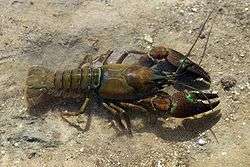Signal crayfish
| Pacifastacus leniusculus | |
|---|---|
| Scientific classification | |
| Kingdom: | Animalia |
| Phylum: | Arthropoda |
| Subphylum: | Crustacea |
| Class: | Malacostraca |
| Order: | Decapoda |
| Family: | Astacidae |
| Genus: | Pacifastacus |
| Species: | P. leniusculus |
| Binomial name | |
| Pacifastacus leniusculus | |
The signal crayfish (Pacifastacus leniusculus) is a North American species of crayfish. It was introduced to Europe in the 1960s to supplement the Scandinavian Astacus astacus fisheries, which were being damaged by crayfish plague, but the imports turned out to be a carrier of that disease. The signal crayfish is now considered an invasive species across Europe, Japan, and California ousting native species there.
Description and ecology

Members of this species are typically 6–9 cm (2.4–3.5 in) long, although sizes up to 16–20.32 cm (6.30–8.00 in) are possible.[3] They are bluish-brown to reddish-brown in colour, with robust, large, smooth claws. They have a white to pale blue-green patch near the claw hinge,[4] like the white flags that signalmen used for directing trains—hence the name.
The lifecycle of the signal crayfish is typical for the family Astacidae. Around 200–400 eggs are laid after mating in the autumn, and are carried under the female's tail until they are ready to hatch the following spring.[3] The eggs hatch into juveniles, which pass through three moults before leaving their mother. Sexual maturity is reached after two to three years, and the lifespan can be up to 20 years.[3]
The signal crayfish is an omnivore, with most of its dietary intake being detritus.[5]
Native range
The signal crayfish is native to North America west of the Rocky Mountains, including the Canadian province of British Columbia, and the U.S. states of Washington, Oregon, and Idaho.[6] It was introduced to California in 1912 into the San Lorenzo River watershed and from there rapidly spread throughout the state.[7] The only native crayfish remaining in California is the Shasta crayfish (Pacifastacus fortis), where efforts are being made to create a barrier to signal crayfish invasion.[8] Within North America, it has also been introduced to Nevada, and the populations in Utah may be the results of introductions.[6] It has also been found in Alaska, specifically Kodiak Island, in the Buskin River and Buskin Lake. It is listed as a species of least concern on the IUCN Red List.[1]
Introduction into Europe

From 1907, crayfish plague, an infectious disease caused by the water mould Aphanomyces astaci, damaged stocks of the native European crayfish Astacus astacus. Since the signal crayfish occupied a similar ecological niche in its native range, it was imported in the 1960s to Sweden and Finland to allow recreational and commercial crayfish capture.[3] At the time, the signal crayfish was not recognized as a carrier of the crayfish plague.[3] All American species carry the infection, but it is only lethal to individuals that are already stressed; to European species, the infection is rapidly fatal.[9]
.jpg)
The signal crayfish is now the most widespread alien crayfish in Europe, occurring in 25 countries, from Finland to Great Britain and from Spain to Greece.[3][10] It was first introduced to Great Britain in 1976, and is now widespread across the British mainland as far north as the Moray Firth. It has also been observed on the Isle of Man, but not in Ireland.[9] Ireland is in the fortunate situation of being the last European country having no alien crayfish.
In both Sweden and Finland (where crayfish are eaten), the catch of signal crayfish exceeds that of the noble crayfish. The former is sold at roughly half the price compared to the latter.[11]
External links
- "Invasion of the Plague Carriers" (RealVideo). The Vega Science Trust. 2002.
- "'Kill crayfish on sight' appeal". BBC News. August 15, 2008.

- "UK Crayfish Website". Buglife – The Invertebrate Conservation Trust.
References
- 1 2 G. A. Schuster; C. A. Taylor & J. Cordeiro (2010). "Pacifastacus leniusculus". The IUCN Red List of Threatened Species. IUCN. 2010: e.T153648A4526314. doi:10.2305/IUCN.UK.2010-3.RLTS.T153648A4526314.en. Retrieved 9 January 2018.
- ↑ "Pacifastacus leniusculus (Dana, 1852)". Integrated Taxonomic Information System. Retrieved August 28, 2010.
- 1 2 3 4 5 6 Trond Taugbøl & Stein I. Johnsen (2006). "Invasive Alien Species Fact Sheet – Pacifastacus leniusculus" (PDF). Online Database of the North European and Baltic Network on Invasive Alien Species. NOBANIS – European Network on Invasive Species. Retrieved August 28, 2010.
- ↑ Mike Averill (1997). "Crayfish in Worcestershire". Worcestershire Record. 2: 4.
- ↑ Carin A. Bondar; K. Bottriell; K. Zeron & John S. Richardson (2005). "Does trophic position of the omnivorous signal crayfish (Pacifastacus leniusculus) in a stream food web vary with life history stage or density?" (PDF). Canadian Journal of Fisheries and Aquatic Sciences. 62 (11): 2632–2639. doi:10.1139/F05-167. Archived from the original (PDF) on 2011-07-08.
- 1 2 James W. Fetzner Jr. (January 14, 2008). "Pacifastacus (Pacifastacus) leniusculus leniusculus (Dana, 1852). Signal crayfish". Crayfish Taxon Browser. Carnegie Museum of Natural History. Retrieved August 8, 2010.
- ↑ Joe Eaton (2005-05-17). "Fighting the Bay Area Invasion of Signal Crayfish". Berkeley Daily Planet. Retrieved 2011-09-04.
- ↑ "PG&E Joins Forces to Save the Endangered Shasta Crayfish". PG&E. Retrieved 2011-09-04.
- 1 2 Richard Chadd & Brian Eversham (2010). "Other invertebrates". In Norman Maclean. Silent Summer: The State of Wildlife in Britain and Ireland. Cambridge University Press. pp. 556–575. ISBN 9781139788694.
- ↑ Silva, S.; Outón, P.; Nachón, D. J.; Gómez-Sande, P.; Sánchez-Hernández, J.; Vieira-Lanero, R. & Cobo, F. (2017). "New data on the introduction of the invasive signal crayfish Pacifastacus leniusculus (Dana, 1852) (Crustacea, Decapoda) and ectosymbiont branchiobdellidans (Annelida, Clitellata) in NW Iberian Peninsula". Nova Acta Científica Compostelana (Bioloxía). 24: 63–68.
- ↑ https://www.fws.gov/fisheries/ans/erss/highrisk/Pacifastacus-leniusculus-ERSS-revision-June2015.pdf
